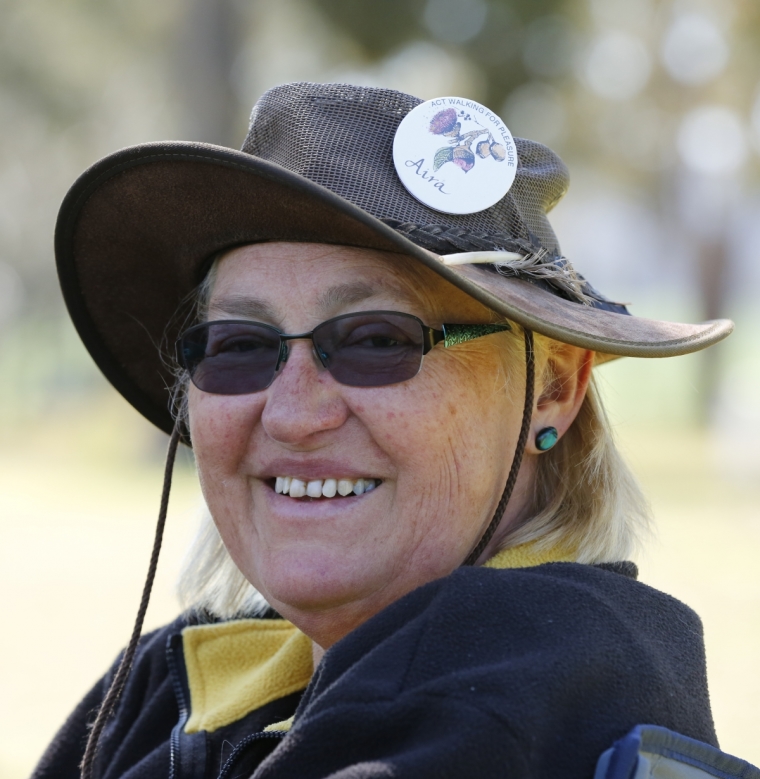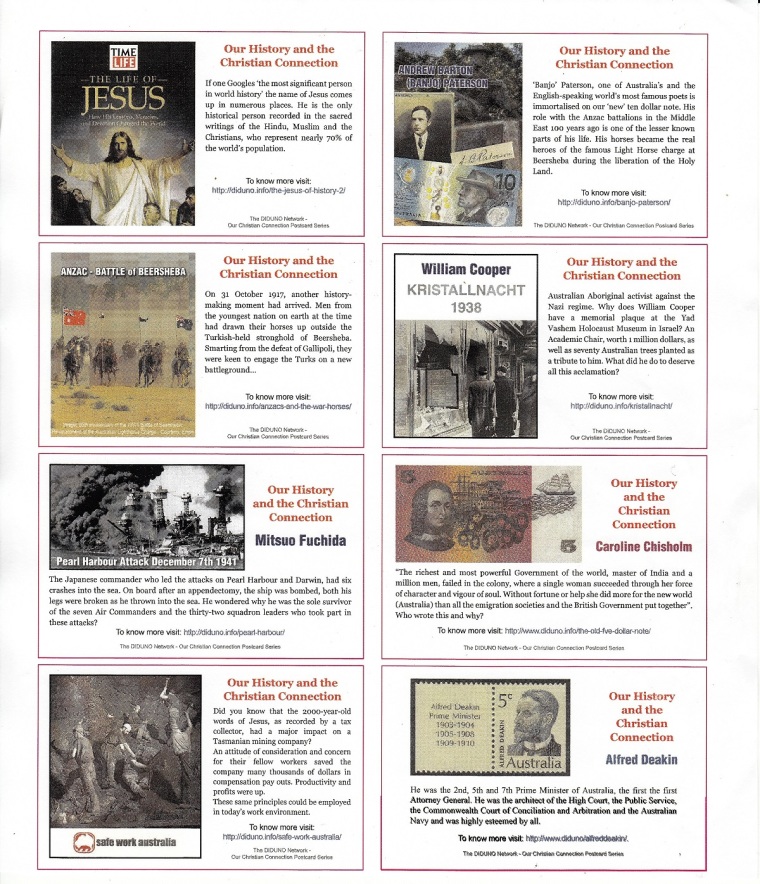
In Psalm 19, David recognized the way creation speaks of the Creator: "The heavens declare the glory of God, the skies proclaim the work of his hands". From time immemorial, people have been aware of the significance of the heavenlies, using patterns to tell their history and to regulate their lives.
We are only just discovering how intricately Aboriginal culture is connected to the skies.
The Dreaming
Aboriginal culture is very complex. There are a great many people groups across the country, with unique languages and customs. There are also many concepts held in common across these groups.
It is hard to define the Dreaming but in this context it's enough to say the Dreaming explains the beginning of all things, the way of life and death and the way things should be. Everything is interconnected – my task is to find those connections.
Songlines
There are said to be "song-lines", consisting of one song, telling one story, that stretch across Australia, following the sacred paths of Dreaming-spirits, and encompassing all these language groups and cultures. They are often identical to the trading routes, and were presumably used for navigating these routes.
In many cases, songlines on the earth are mirrored by songlines in the sky. The sky is used as a navigational tool, both by using it as a compass, and by using it as a mnemonic to remember the songlines on the ground. (Norris and Harney, 2014). For shorter journeys or when a songline was not available, the direction of the Moon or patterns of the stars were used for navigation.
For example, the Euahlayi people (NSW/Qld) know the Black Snake/Bogong Moth songline connecting Normanton on the Gulf of Carpentaria with the Snowy Mountains near Canberra, and which also follows the Milky Way.
Atmospheric physics
Observation of the stars also resulted in a detailed understanding of the physics of the atmosphere. For example, the twinkling of stars and their colour gives information about how fast the air moves (the faster the twinkle, the more rapid the air movement), how much moisture it contains (fuzzy and blue appearance means moisture in the air), and temperature and pressure variations. (ABC Radio National).
The halo around the moon – its width, opacity and distance between the moon and the halo – indicates bad weather and the amount of moisture contained in the atmosphere.
Sun, moon and planets
The planets were known by their movement across the ecliptic, which is the Dreaming track across the sky. Aboriginal elders also understood how the whole pattern rotated over their heads from east to west during the night, and how it shifted over the course of a year.
In one of their stories, Walu the sun is a woman who lights her fire every morning and scatters red ochre across the clouds, creating dawn. She then carries her torch across the sky, creating daylight. At the end of the day, she descends, puts out her fire, and travels underground through the night back to her morning camp.
Compare this to the Psalmist who describes the sun, in this case with male imagary, as he traverses the sky. (Psalm chapter 19 verses 4 – 6).
The Yolngu people in Arnhem Land have dreaming stories that explain tides, eclipses, the rising and setting sun and moon and the changing positions of rising stars and planets throughout the year.
For example, when Yolngu people die, they are taken by a mystical canoe, Larrpan, to the spirit-land (Baralku) in the sky, where you can see their camp-fires burning along the edge of the great river of the Milky Way. The canoe is sent back to earth as a shooting star, letting their family on Earth know that they have arrived safely in the spirit-land.
In many cultures (but certainly not all) the Moon is male and the Sun is female, and there are many different versions of stories, in different languages, in which the Moon-man falls ill (the waning Moon), lies dead for three nights (New Moon), and then resurrects on the third day (the waxing Moon).
Agriculture by the stars
Depending upon the position of the Milky Way, people in the western desert knew it was time to hunt for emus or collect their eggs.
The evening appearance of the celestial shark, Baidam traced out by the stars of the constellation Orion tells Torres Strait Islanders that they need to plant their gardens with sugarcane, sweet potato and banana. When the nose of Baidam touches the horizon just after sunset, the shark breeding season has begun and people should stay out of the water as it is very dangerous!
When the Pleiades star cluster rises just before the morning sun, it signifies the start of winter to the Pitjantjatjara people of the Central Desert and tells them that dingoes are breeding and will soon be giving birth to pups.

The Emu in the Sky
The Emu in the Sky stretches across the Milky Way. (Source: Barnaby Norris).
Whereas in Greek mythology, where many of the star patterns are hard to recognize (except perhaps for Scorpius with the curling tail), the Aboriginal people used the dark patches as well as prominent stars to tell their stories. The Emu is stretched across one of the most familiar objects in the night sky, the Milky Way.
How the emu came to be in the sky: During the Dreaming, a man's wife went into the bush to hunt for emu eggs. One day, she came across some very large emu tracks and followed them all the way to the nest. She found a huge emu there and threw stones at it to get at the eggs, but it stood up and ran towards her and killed her.
The man became hungry and worried about his wife. He made some spears and a woomera and set off to find his wife. He followed her tracks and finally saw the huge emu and the body of his wife. He speared the emu and banished its spirit to the Milky Way, where it can still be seen today.

Orion the Hunter – moral law
Orion the hunter appears as Djulpan to the Yolgnu people in the Northern Territory. (Source: Ray Norris)
The Yolngu tell the story of three brothers of the King-fish (Nulkal) clan who went fishing, but all they could catch were king-fish. Traditional lore forbade them to eat these fish because they were in the king-fish clan.
Eventually, one of the brothers became so hungry that he decided to break the law, and caught and ate a king-fish. The Sun-woman (Walu) saw this, and was so angry at him for breaking the law that she created a waterspout that lifted them right up into the sky in the Djulpan constellation (Orion the Hunter).
The three stars in Orion's belt are the brothers sitting side by side, with the stars Betelgeuse and Rigel marking the front and back of the canoe. The stars in Orion's nebula represent a fish, and the stars of Orion's sword mark out a fishing line trailing behind the canoe.
Thus this constellation is a reminder that you'd better not break the law!

Pleiades – another moral law
This beautiful image of the Pleiades cluster was produced by David Malin of the Anglo-Australian Observatory and is the copyright of the Anglo-Australian Observatory and the Royal Observatory, Edinburgh.
The Pleiades are often taken to be seven young women who went gathering food and were followed by the Djulpan brothers from a different skin. The keepers of the Dreamtime realized that the skin groups were wrong for mating, so they lifted the sisters into the sky.
The two men at the ends of the group of seven stars are still chasing the women but are destined by the spirits never to catch them. This shows the importance of right group relationships.
The Southern Cross
To the Ngarrindjeri people, the dark shape formed by the Southern Cross is the stingray Nunganari and the pointers are Ngarakani, or sharks that chase the stingray across the sky. In other stories it is an eagle's footprint.

From southern Queensland comes a story that tells the origin of the Southern Cross. Biami, the Good Spirit in the sky, was extremely busy keeping an eye on the Aboriginal people but found he could not watch them all the time. He decided that he needed the assistance of someone to help him in the guardianship of his people. He chose a man named Mirrabooka, who was not only loved by everyone but also looked after the welfare of his tribe.
So, "Biami gave him a spirit form and placed him in the sky among the stars, and promised him eternal life. Biami gave Mirabooka lights for his hands and feet and stretched him across the sky, so that he could watch for ever over the tribes he loved. And the tribes could look up to him from the Earth and see the stars which were Mirrabooka's eyes gazing down on them," (Walker 1972).
When the white people came, they named Mirrabooka the Southern Cross.
The Magi
Little wonder that the Magi looked to the skies and followed the Star (supernova?) in their effort to find Jesus (Matthew chapter 2, verses 1-12).
References and source material
www.emudreaming.com Many thanks to Ray Norris for permission to use his images and material.
http://members.optusnet.com.au/virgothomas/space/abobeliefs2.html#Two%20Brothers for other stories
https://theconversation.com/a-shark-in-the-stars-astronomy-and-culture-in-the-torres-strait-15850 http://astrogeo.oxfordjournals.org/content/47/5/5.27.full http://www.abc.net.au/science/articles/2009/07/27/2632463.htm (Emu in the Sky story)
http://podbay.fm/show/73330054/e/1477098302?autostart=1 ABC RN aboriginal astronomy

Aira Chilcott B.Sc (Hons), M. Contemp Sci, Cert IV in Christian Ministry and Theology, Cert IV in Training and Evaluation, Grad Dip Ed., began her working life at the John Curtin School of Medical Research, investigating characteristics of cancer cells. Turning to teaching in the Christian school system provided opportunities to learn theology, more science, mission trips and explore the outdoors through bushwalking and other exploits. Now retired, Aira is a panelist for Young Writers and volunteers at a nature park. Aira is married to Bill and they have three adult sons.
Aira Chilcott's previous articles may be viewed at http://www.pressserviceinternational.org/aira-chilcott.html